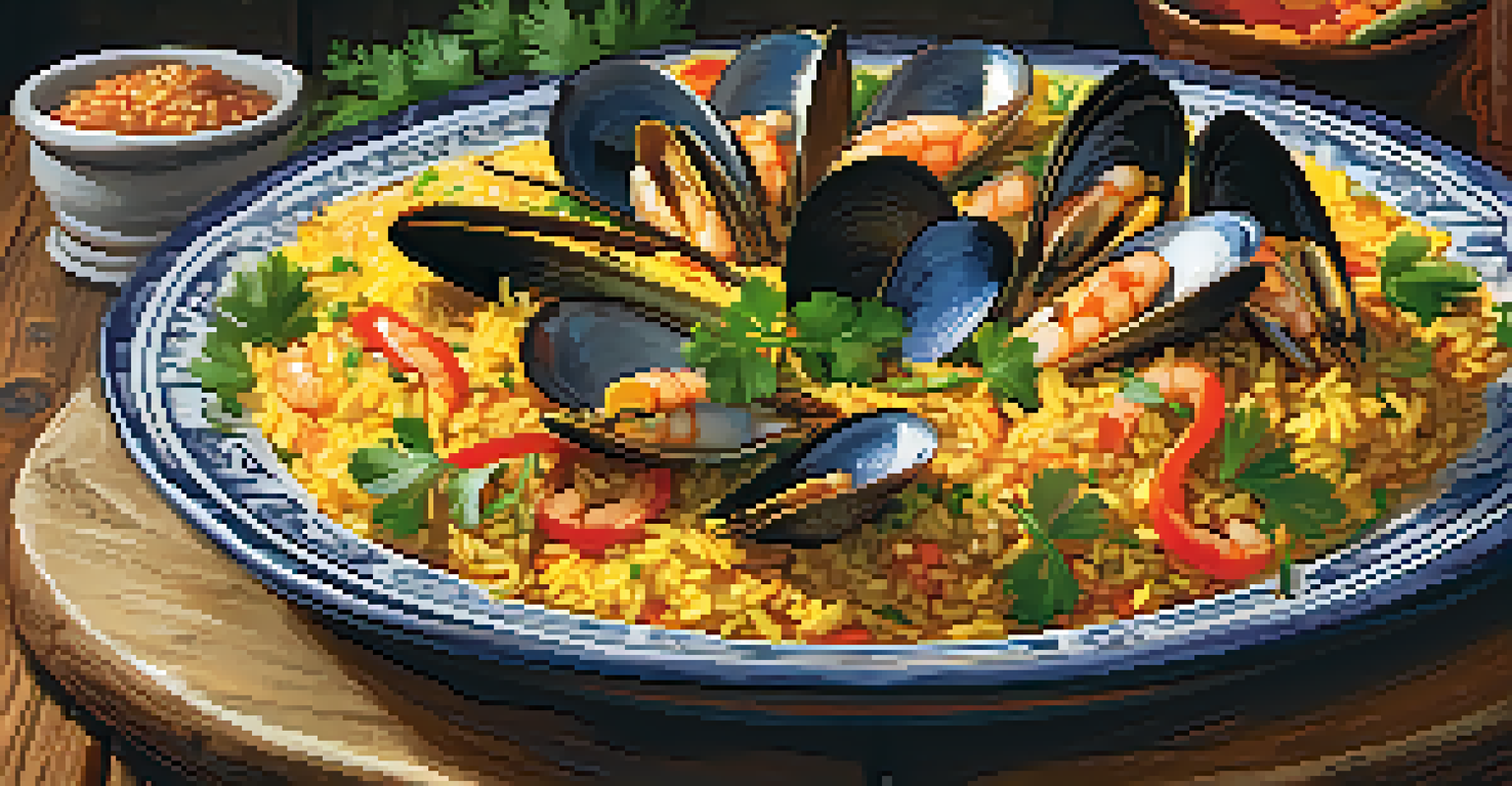Gastronomic Heritage: Spain's Regional Cuisines Explored

The Essence of Gastronomic Heritage in Spain
Spain's culinary landscape is a vibrant tapestry woven from its rich history and diverse cultures. Each region boasts unique ingredients and traditional cooking methods that reflect local customs and agricultural practices. This gastronomic heritage is not just about food; it's a way of life that connects communities and preserves cultural identity.
Food is our common ground, a universal experience.
When we talk about gastronomic heritage, we're referring to the practices, recipes, and knowledge passed down through generations. For instance, the use of saffron in Valencia's paella symbolizes the region’s agricultural roots and its historical trade routes. Through food, we can explore the stories and experiences of the people who have shaped Spain's identity.
As we venture deeper into Spain's regions, we’ll discover how climate, geography, and history influence local cuisines. From the seafood-rich coasts of Galicia to the hearty stews of Castilla-La Mancha, each dish tells a story that reflects its origins and the people who create it.
Andalusia: The Soul of Spanish Cuisine
Andalusia is often considered the heart of Spanish cuisine, known for its bold flavors and vibrant dishes. Tapas, a quintessential Andalusian tradition, highlight the social aspect of dining, inviting people to share small plates of food while enjoying each other's company. From olives to seafood, the variety is endless and reflects the region's agricultural bounty.

One of the standout dishes is gazpacho, a refreshing cold soup made from ripe tomatoes, peppers, and cucumbers. This dish not only provides relief from the summer heat but also showcases the region's fresh produce. Each family has its own recipe, emphasizing the personal touch that defines Andalusian cooking.
Spain's Culinary Heritage Shines
Spain's diverse regional cuisines reflect a rich tapestry of history, culture, and local ingredients.
Moreover, the influence of Moorish cuisine is evident in Andalusia, where spices like cumin and coriander add depth to traditional dishes. This fusion of flavors is a testament to the region's complex history and its embracing of diverse culinary traditions.
Catalonia: A Culinary Mosaic of Tradition and Innovation
Catalonia offers a unique blend of traditional and contemporary cuisine, making it a culinary hotspot in Spain. Dishes like calçots (grilled green onions) served with romesco sauce exemplify the region's celebration of local ingredients and seasonal produce. The vibrant markets in Barcelona are a feast for the senses, showcasing everything from fresh seafood to artisanal cheeses.
The discovery of a new dish does more for the happiness of mankind than the discovery of a star.
One cannot discuss Catalonia without mentioning its famed dish, pa amb tomàquet, which is simply bread rubbed with ripe tomatoes and drizzled with olive oil. This humble yet flavorful dish reflects the region's philosophy of using high-quality, local ingredients to create memorable meals. It’s a perfect example of how simplicity can lead to extraordinary flavors.
Catalan cuisine also embraces innovation, with chefs experimenting and redefining traditional dishes. This dynamic approach attracts food enthusiasts from around the world, eager to experience the fusion of time-honored recipes with modern culinary techniques.
The Basque Country: A Culinary Frontier
The Basque Country is renowned for its gastronomic prowess, often considered one of the best culinary destinations in the world. Its unique blend of land and sea gives rise to an array of flavors, with pintxos (Basque tapas) showcasing the region's creativity and attention to detail. These small bites are often beautifully presented, inviting diners to savor each morsel.
One signature dish is bacalao a la vizcaína, a codfish stew that combines rich flavors with a hint of spice. The dish exemplifies the Basque commitment to high-quality ingredients and traditional preparation methods. Each bite reveals the passion that Basque chefs pour into their craft, making every dining experience unforgettable.
Andalusia: Heart of Spanish Cuisine
Known for its bold flavors and social dining traditions, Andalusia offers iconic dishes like tapas and gazpacho.
Additionally, the Basque Country’s commitment to culinary education has produced some of the world's top chefs. Their innovative spirit and respect for tradition continue to shape the global culinary landscape, making it a must-visit for food lovers.
Galicia: A Seafood Lover's Paradise
Galicia is often referred to as Spain's seafood capital, thanks to its rugged coastline and rich marine life. The region's culinary identity is deeply intertwined with the Atlantic Ocean, producing some of the freshest seafood you can find. Dishes like pulpo a la gallega (octopus seasoned with paprika and olive oil) showcase the simplicity and depth of Galician cuisine.
In addition to seafood, Galicia boasts a variety of local ingredients, including potatoes and peppers. The Galician empanada, a savory pastry filled with meat or fish, is a beloved dish that reflects the region's agricultural and maritime heritage. Each family has its own recipe, making it a cherished tradition at gatherings and celebrations.
Moreover, Galicia's commitment to sustainability is evident in its fishing practices, ensuring that the region's culinary treasures are preserved for future generations. This respect for the ocean and its bounty is a core element of Galician culture, deeply embedded in its culinary traditions.
Valencia: The Birthplace of Paella
Valencia holds a special place in the hearts of food lovers, primarily as the birthplace of paella. This iconic dish, made with rice, saffron, and a variety of proteins, is a celebration of local ingredients. The region's fertile landscape produces some of the best tomatoes, beans, and seafood, making it a culinary paradise.
Paella is more than just a dish; it’s a communal experience. Traditionally cooked in a large, shallow pan over an open flame, it's often enjoyed during family gatherings and celebrations. The preparation itself becomes a festive occasion, bringing people together to enjoy the fruits of their labor.
Catalonia Blends Tradition and Innovation
Catalonia's culinary scene celebrates local ingredients while embracing modern techniques, attracting food enthusiasts worldwide.
Valencia also boasts a rich agricultural tradition, with orchards producing fresh fruits and vegetables that feature prominently in its cuisine. Dishes like horchata, a refreshing drink made from tiger nuts, highlight the region's agricultural diversity and commitment to using local ingredients.
Castilla-La Mancha: Hearty Flavors of the Heartland
Castilla-La Mancha is known for its hearty and rustic cuisine, reflective of its historical roots and agricultural landscape. The region is famous for its manchego cheese, a staple that showcases the quality of local sheep’s milk. This cheese is often paired with local wines, creating a delightful gastronomic experience.
Another iconic dish is pisto, a ratatouille-like mixture of vegetables often served with a fried egg. This simple yet flavorful dish highlights the importance of seasonal vegetables in Castilla-La Mancha’s cooking. It’s a testament to how local produce can create satisfying and nourishing meals.

Moreover, the region's rich history is evident in its culinary practices, with many recipes passed down through generations. The connection between the land and the food is palpable here, making every meal a celebration of tradition and heritage.
The Diversity of Spanish Cuisines: A Culinary Journey
Exploring Spain's regional cuisines is akin to embarking on a culinary journey through time and tradition. Each region offers a unique perspective on food, showcasing the diversity of flavors, ingredients, and cooking techniques that characterize Spanish gastronomy. From the coastal delights of Galicia to the hearty dishes of Castilla-La Mancha, every meal tells a story.
This culinary richness is not only a reflection of geography but also of cultural influences that have shaped Spain over centuries. The fusion of different traditions, from Moorish to Mediterranean, has resulted in a vibrant food culture that continues to evolve today. It’s a beautiful reminder of how food can connect us to our roots and to each other.
As we savor the flavors of Spain, we celebrate more than just the dishes; we honor the communities and the stories behind them. Gastronomic heritage is a living, breathing entity that invites us to explore, taste, and appreciate the diverse tapestry of Spanish cuisine.